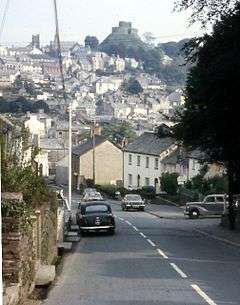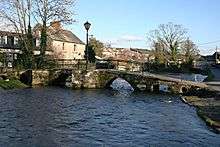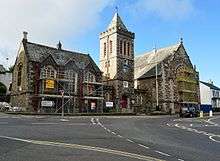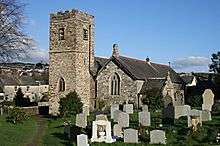Launceston, Cornwall
| Launceston | |
| Cornish: Lannstevan | |
 Town Square |
|
 Town centre from Saint Stephen's Hill showing the prominent, wood-clad Launceston Castle |
|
 Launceston |
|
| Population | 11,700 (2011 census)[1]) |
|---|---|
| Motto | Royale et Loyale |
| OS grid reference | SX335845 |
| Civil parish | Launceston |
| St Stephens by Launceston Rural | |
| Unitary authority | Cornwall |
| Ceremonial county | Cornwall |
| Region | South West |
| Country | England |
| Sovereign state | United Kingdom |
| Post town | LAUNCESTON |
| Postcode district | PL15 |
| Dialling code | 01566 |
| Police | Devon and Cornwall |
| Fire | Cornwall |
| Ambulance | South Western |
| EU Parliament | South West England |
| UK Parliament | North Cornwall |
Coordinates: 50°38′06″N 4°21′14″W / 50.635°N 4.354°W
Launceston (/ˈlɑːnstən/ LARN-stən or /ˈlɔːnstən/ LAWN-stən, locally /ˈlænsən/ LAN-sən or /ˈlɑːnsən/ LARN-sən, (Cornish: Lannstevan;[2] (rarely spelled Lanson often as an abbreviation) is a town, ancient borough, and civil parish in east Cornwall, England, UK. It is one mile (1.6 km) west of the River Tamar, which constitutes almost the entire border between Cornwall and Devon, at its middle stage. Its gradients are generally steep particularly at a sharp south-western knoll topped by Launceston Castle.[3]
The town centre is bypassed and is no longer physically a main thoroughfare. However, the town remains figuratively the "gateway to Cornwall", due to having one of the two dual carriageways into the county pass directly next to the town. The other dual carriageway and alternative main point of entry is at Saltash over the Tamar Bridge and was completed in 1962.
Launceston Steam Railway narrow-gauge heritage railway runs for aesthetic and industrial heritage purposes along a short rural route, it is popular with visitors during the summer months, but does not run for much of the year.
Launceston Castle was built by Robert, Count of Mortain (half-brother of William the Conqueror) c. 1070 to dominate the surrounding area. Launceston was the caput of the feudal barony of Launceston and of the Earldom of Cornwall until replaced by Lostwithiel in the 13th century. Launceston was later the county town of Cornwall until 1835 when Bodmin replaced it.
Two civil parishes serve the town and its outskirts, of which the central more built-up administrative unit housed 8,952 residents at the 2011 census.[4]
Three electoral wards include reference to the town, their total population, from 2011 census data, being 11,837 and two ecclesiastical parishes serve the former single parish, with three churches and a large swathe of land to the north and west part of the area.
Launceston's motto is a reference to its adherence to the Cavalier cause during the English Civil War of the mid-17th century.
History
The Cornish name of "Launceston", Lannstevan, means the "church enclosure of St Stephen" and is derived from the former monastery at St Stephen's a few miles north-west (the castle and town were originally named Dunheved) and the Common Brittonic placename element lan-. Dunheved was the Southwestern Brittonic name for the town in the West Saxon period.
The earliest known Cornish mint was at Launceston, which operated on a minimal scale at the time of Æthelred the Unready before Cornwall received full diocesan jurisdiction in the year 994 AD. Only one specimen is known to exist. In the reign of William the Conqueror, the mint was moved to Dunheved and remained in existence until the reign of Henry II, 1160.[5] During the reign of Henry III of England, another mint was established in Launceston.
Launceston Castle, in good repair, is a Norman motte-and-bailey castle, and was built by Robert, Count of Mortain (half-brother of William the Conqueror) c. 1070 to dominate the surrounding area. Launceston was the caput of the feudal barony of Launceston and of the Earldom of Cornwall until replaced by Lostwithiel in the 13th century. Launceston was later the county town of Cornwall until 1835 when Bodmin replaced it. The lands of Robert, Count of Mortain, became the core holdings of the feudal barony of Launceston, and the Fleming family continued to hold most of their manors from that barony, as can be seen from entries in the Book of Fees.
In Domesday Book (1086) it is recorded that Launceston was held by the Count of Mortain, and that he had his castle there. There was land for 10 ploughs, 1 villein and 13 smallholders with 4 ploughs, 2 mills which paid 40/- (£2 sterling) and 40 acres of pasture. The value of the manor was only £4 though it had formerly been worth £20.[6]
The Roman Catholic martyr Cuthbert Mayne was executed at Launceston — a legacy of memorials and a church exists.
Civil War
During the English Civil War Launceston was known to be Royale et Loyale to Charles I of England, hence its coat of arms. His son, who was later crowned Charles II of England, stayed in the town for a couple of days en route to the Cavalier army based further west.
In 1643, the Parliamentarian forces under the command of Major General James Chudleigh advanced in an attempt to capture Launceston from the Royalists. The Royalist commander, Ralph Hopton, 1st Baron Hopton, stationed his forces on the summit of Beacon Hill, a steep hill which overlooks the town. The Parliamentarians captured the foot of the hill, but were unable to dislodge the Royalist forces from the top. Hopton led a counterattack down the hill and, despite fierce fighting and the arrival of Parliamentary reinforcements, forced Chudleigh's troops to retreat.[7]
Sir Richard Grenville, 1st Baronet was committed by Prince Charles to Launceston Prison for refusing to obey Lord Hopton; Grenville had already quarrelled with General George Goring, Lord Goring.[8]
Later history
Launceston has the only document in the UK signed by Mary II of England and her husband, William III of England. Launceston is said to have gained its historical importance from being the furthest into Cornwall that Justices and other Officers of the Crown felt safe to venture. (A more realistic reason was the very poor means of transport within Cornwall at the time which did not begin to be improved until the late 18th century.) When the situation had been improved Bodmin became the county town where the assizes were held (in 1835). Launceston's role as the de facto county town of Cornwall became established in the 13th century but it was never officially designated as the county town.[9]
Viscount Launceston was a title of nobility created in 1726 (as Viscount of Launceston) but is now extinct. In the early 19th century, Launceston gave its name to the settlement, Launceston, Tasmania, which is now the second largest city in Tasmania.
Geography

Launceston is a market town, castle, recreational and heritage railway visitor town and the main shopping centre for the adjoining rural areas of west Devon and east Cornwall. The town is mainly built on the south side of a large hill almost immune to flooding, unlike its northern neighbourhood, Newport in part on a slightly wider plain at the bottom of the hill, which is susceptible to flooding by the River Kensey.
The suburb of Newport is recorded for the first time during the 13th century. The natural advantages of the Launceston district had been recognised by the Anglo-Saxon monks of St Stephen and by the Norman lord of Cornwall in the reign of King William I. At this point in the course of the River Tamar it is joined by four tributaries within a short distance and its flood plain is relatively large, while further south the Tamar valley is narrow and meandering.[9]
Launceston is connected to the A30 trunk route, a dual carriageway bypass carrying its road traffic south of the town. The bypass crosses the River Tamar on the Dunheved Bridge built in 1975-6 mdash; substantially rebuilt 2006-7.[10] Through this the town is approximately 42 miles (67 km) west of Exeter, 26 miles (42 km) north-east of Plymouth and 21 miles (34 km) east of the smaller regional centre of Bodmin. It is roughly midway between the north coast of Cornwall (at Bude) and the south coast (at Saltash).
Launceston civil parish comprises the town whereas St Stephens by Launceston Rural civil parish covers all outskirts, save for those south of the town. These each convene to discuss events funding, recreational funding and general planning matters.[11]
Stourscombe SSSI, a geological Site of Special Scientific Interest, one mile to the east of Launceston, is designated ″... for the best inland exposure of the Upper Devonian in South West England and the type locality of the Stourscombe Beds (Upper Famennian).″[12]
Administration

Launceston was a Parliamentary Borough from medieval times, with the right to return two members of parliament. However, as was the law at the time. The right to vote was not held by all the residents but only by the freemen of the borough, and by the 19th century there were fewer than 50 and it had come to be regarded as a rotten borough, one of many in Cornwall. Neighbouring Newport was also a borough with two MPs of its own. Launceston lost one of its two MPs and Newport both by the Great Reform Act of 1832; the area included in the borough of Launceston was considerably extended to enable the franchise to be opened up. It finally lost its right to separate representation in 1885. It is now part of the North Cornwall parliamentary constituency. The current MP is Scott Mann.
Launceston was once the capital of Cornwall (before this title passed to Bodmin in 1835), and in 1973 the Prince of Wales visited to receive his feudal dues from the Duchy of Cornwall.
The arms of the town are Gu. a triple circular tower in a pyramidical form Or the first battlements mounted with cannon of the last, all within a bordure Az. charged with eight towers domed on the second. A badge was granted on 26 Mar 1906, being the first ever granted to a civic body: A keep or castle Gold.[13]
Launceston is twinned with Plestin-les-Grèves in Brittany, France.[14]
Economy
The outskirts of Launceston specialise in large businesses with convenience, niche and fine weather tourist-catering commerce in the town centre. The three main industrial estates are Pennygillam, Scarne and Newport. The employment of immigrants from mainly Eastern European countries has allowed the town to sustain some of its primary industries, which it might not otherwise have been able to support due to the low number of potential employees in the existing population.
The town has many restaurants, cafés, take aways and ten pubs being fewer than in the Victorian era with the larger ones tending to survive which specialise in their food, others of which provide live music events on a weekly basis. Launceston has one nightclub.
A tucking mill was established in the 15th century by the Flemings in the north of the town (Newport), water-powered, continuing in use for corn until 1968. A manuscript left by Richard Robbins (died 1910) records eight tanneries in the town in the 19th century. A mechanics' institute was founded in 1847 at the Central Subscription Room. The gasworks was established as early as 1834 by Waygood & Porter of Beaminster.[15]
The Duchy Originals company first manufactured its products in 2006 by opening a factory in Launceston making sweet and savoury pastry products but made a loss of £447,158 in the financial year 2006/7.[16] During 2009 the bakery in Launceston was sold at a loss, contributing to the Duchy Originals company making a loss for 2009 - 10.[17]
The Natural Fibre Company (TNFC) is a British wool mill based in Launceston and is the only small-scale full range textile mill in the UK. The main focus of the business is to add value to naturally coloured raw fleece which is bought from farmers, smallholders and rare sheep breeders.
Culture
The poet Charles Causley was a native and long-standing resident of the town where he was both born and died. He was at one time contender for Poet Laureate and died in 2003, aged 86. He contributed the account of Launceston to a feature in the Sunday Times magazine called "Village England". He describes it as belonging to England rather than to Cornwall "[18] Launceston is one of the most important towns in Daphne du Maurier's novel Jamaica Inn.
Launceston annually hosted the "Castle Rock" music festival in July, which took place on the lower grounds of the castle which overlooks the town (within the outer walls). As well as a vibrant mix of local bands, the 2006 festival was headlined by Capdown which massively improved the event's profile. The first concert was performed in 2000 and featured a young artist who was unknown at the time, Jamie Cullum. The festival was headlined on two occasions by local Rock band Syrup, who were signed to Great West Records, which was set up by Big Country bass player, Tony Butler, and his long term friend, Luke Maguire.
The Cornish & Devon Post is one of the newspapers for the district and its office is in the town. Local-specific editions of the paper and other publications are produced. It was founded in 1856 and incorporates the Launceston Weekly News. The Cornish Guardian North Cornwall edition covers Launceston. Four FM radio stations can be received: BBC Radio Cornwall, Pirate FM, Heart South West, and Radyo an Gernewegva (online or via large aerials). In December 2013 a periodic community audio magazine was incepted The Launceston Podcast with catch-up services online.[19]
Sporting clubs include amateur football club Launceston F.C. who play at Pennygillam, rugby union side Launceston R.F.C., Launceston Cricket Club, Launceston Golf Club and Dunheved Bowling Club.[20]
Places of worship

Three Anglican churches are in the town which has a united benefice and ecclesiastical parish covering Tregadillett three miles west, the same clergy alternating services to provide for a large attendance and operating a combined website.[21]
The Grade I listed church of St Mary Magdalene was built in 1511–1524 by Sir Henry Trecarrel of Trecarrel near the town as a memorial to his infant son who died whilst being bathed. The ornate carvings in granite originally carved for the mansion he began to build at Trecarrel, Lezant have withstood the test of time. The tower dates from the 14th century, an earlier church and graveyard having occupied the site. Its grand organ was presented by a member of the Morice family of Werrington Park. The donor was either Sir William Morice, 3rd Baronet (1707–50)[22] or his successor Humphry Morice MP (1723–85). The casework is elaborate, "a superb example of 18th century woodwork; the 18th century pipework is also of very high quality."[23][24]
On St Stephen's Hill the main road through the north of the town is the Roman Catholic Church to Cuthbert Mayne (see #History) designed by Arthur Langdon in a blend of Byzantine and Romanesque. It was built in 1911 by local mason F H Nicholls of Lewannick, with carpentry by J H Harry, the oak doors by Mr Clifton of Ashwater, and the copper dome by T Chapman (Junior) of Launceston. The Lady Chapel was added in 1933.[25][26]
Education
Five schools are in the town:
- Three primary schools (St Catherine's Church of England Primary, St Stephen's Community Primary School and Launceston Community Primary School) cater for pupils aged 4 to 11.
- 'St. Joseph's School', St Stephens Hill is an independent day school for boys and girls from age 3, going from nursery through the early years, junior department and into the senior school. The senior school boys and girls have been accepted into the sixth form from September 2012.[27]
- Launceston College was first established in 1409 and became a boys grammar school with boarding house before becoming fully inclusive and educating students aged 11 to 18 or 19.
A former student of the latter is actor Sir Roger Moore. In 1962, Horwell Grammar School for Girls, Dunheved Road, was merged with the school and in 1965 the former Pennygillam School was added to form the present day comprehensive school which is still known as Launceston College. Since the 19th century (exact date unknown) the College has been at the southern end of Dunheved Road, approximately one kilometre from the town centre. In 1966 H. Spencer Toy its principal published A History of Education at Launceston detailing the development of education in the town and surrounding area.
Launceston Community Primary School has the colloquial pseudonym Windmill Primary School, adjacent to the site of the town's former windmill for grinding grain in Coronation Park.
Notable buildings
Part of the town wall is still in existence including the South Gate of two arches. The White Hart Hotel incorporates a Norman doorway possibly removed from the Castle. New Bridge (early 16th century) crosses the River Tamar: it is of granite. Two old bridges cross the River Kensey: one mediaeval and one built in 1580. The Baptist chapel is late 18th century and a number of Georgian houses may also be seen.[28]
Three nonconformist churches/chapels served the 19th century town: Wesleyan Methodist, Bible Christian, and Calvinist.[29] North Cornwall and West Devon's Elim Pentecostal Church is in the town. A church built a Launceston site in 2010, Gateway 2 New Life at the Gateway Centre, having redeveloped a tax office.[30]
Transport
Launceston, having no connected railway, was for almost a century served by two railway lines in the national network. The Great Western Railway (GWR) branch from Plymouth terminated in the town and the London and South Western Railway (LSWR) Exeter to Padstow North Cornwall Railway passed through. The stations were adjacent. The GWR station closed to passengers in 1952 after which all trains used the LSWR station until the North Cornwall line closed in 1966 until re-opened for the heritage steam railway. The Launceston Steam Railway narrow-gauge heritage railway uses the nearest section of the former North Cornwall line. It runs from Launceston station westward 2.5 miles (4.0 km) to Newmills along the valley of the Kensey.
Notable residents
The writer and historian, Joan Rendell lived at Yeolmbridge near Launceston.[31]
- Francis Vyvyan Jago Arundell was born at Launceston in July 1780, being the only son of Thomas Jago, a solicitor in that town, who had married Catherine, a daughter of Mr. Bolt, a surgeon at Launceston. He was in later life the Rector of Landulph, an antiquary and an oriental traveller.
- Charles Causley, poet
- Mary Ann Davenport, actress, born at Launceston in 1759
- James Ruse, a Cornishman from Launceston, arrived in New South Wales aboard the transport Scarborough, part of the First Fleet of Australian convict ships, in 1788.[32]
- John McGeoch, seminal new wave guitarist
References
- ↑ "Launceston Town populations 2011 census". Cornwall.gov.uk. Retrieved 7 February 2015.
- ↑ "List of Place-names agreed by the MAGA Signage Panel" (PDF). Cornish Language Partnership. May 2014. Retrieved 2015-01-11.
- ↑ Ordnance Survey: Landranger map sheet 201 Plymouth & Launceston ISBN 978-0-319-23146-3
- ↑ "Launceston, St Mary Magdalene". GENUKI: UK & Ireland Genealogy. Retrieved 7 February 2015.
- ↑ Cornish Church Guide (1925) Truro: Blackford; p. 198
- ↑ Thorn, C., et al., eds. (1979) Cornwall. (Domesday Book; 10.) Chichester: Phillimore; entry 5,1,22
- ↑ "Cornwall and Devon, 1643". British-civil-wars.co.uk. 2014-10-19. Retrieved 2015-04-09.
- ↑ "The Cornwall Register: Containing Collections Relative to the Past and ... - John Wallis - Google Books". Google.co.uk. Retrieved 2015-04-09.
- 1 2 Balchin, W. G. V. (1967) Cornwall: a description of the Ordnance Survey seventh edition one-inch sheets covering Cornwall. (British Landscapes through Maps.) Sheffield: Geographical Association; p. 25
- ↑ "Highways Agency press release: Dunheved Bridge". Highways Agency. Retrieved 19 April 2010.
- ↑ "Launceston Ward population census 2011". Ukcensusdata.com. Retrieved 7 February 2015.
- ↑ "Stourcombe Quarry" (PDF). Natural England. Retrieved 6 November 2011.
- ↑ Pascoe, W. H. (1979) A Cornish Armory. Padstow: Lodenek Press; pp. 133, 136
- ↑ "Latest News from Twinning Association". Launceston-tc.gov.uk. Retrieved 17 January 2012.
- ↑ Todd, A. C. & Laws, Peter (1972) The Industrial Archaeology of Cornwall. Newton Abbot: David & Charles; p. 231
- ↑ "Duchy Originals Foods Ltd Accounts 2006/7". Companieshouse.gov.uk. Retrieved 2015-04-09.
- ↑ Dean Best (2010-02-11). "Just Food -UK: Duchy Originals reports loss as sales slump". Aroq Ltd. Retrieved 2010-03-31.
- ↑ "Launceston ... still encloses a particularly secret and inward-looking community. If an eye is cast beyond itself at all it is in the direction of England: half-marooned from the rest of Cornwall as we were until a century ago by the dangerous barrier of Bodmin Moor."--Village England, p. 7
- ↑ Launceston Podcast Soundcloud.com Accessed 1 June 2015.
- ↑ "Launceston R.F.C. website". Cornishallblacks.co.uk. Retrieved 9 June 2009.
- ↑ Three churches and two parishes of Launceston The Church of England. Accessed 1 June 2015.
- ↑ "The Acorn Archive - Sir William Morice, Knight; and his descendents". Freepages.family.rootsweb.ancestry.com. Retrieved 2015-01-28.
- ↑ Rendell, Joan (1982) Cornish Churches. St Teath: Bossiney Books; p. 10
- ↑ Church of St Mary Magdalene (Anglican, 1511) Historic England. "Details from listed building database (1280301)". National Heritage List for England.
- ↑ Church of St Cuthbert Mayne (Roman Catholic, 1911) Grade II listing. Historic England. "Details from listed building database (1297829)". National Heritage List for England.
- ↑ "Launceston St Mary Magdalene". GenUKI. Retrieved 17 April 2010.
- ↑ "St Joseph's School - Launceston, Cornwall". Stjosephscornwall.co.uk. Retrieved 2015-04-09.
- ↑ Pevsner, N. (1970) Cornwall, 2nd ed. Penguin Books
- ↑ GenUKI, op. cit.
- ↑ "Home". Gateway2newlife.co.uk. Retrieved 2015-01-28.
- ↑ "BBC News - Blanket fire led to Joan Rendell death". BBC Online. 30 November 2011. Retrieved 25 September 2014.
- ↑ Tolchard, C. (1965) The Humble Adventurer. Melbourne: Lansdowne Press
External links
- Launceston Town Council
- Launceston at DMOZ
- Online Catalogue for Launceston at the Cornwall Record Office